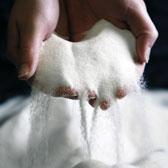-

-
Blackburn notes the following reasons for the increase of iodine deficiencies in the U.S.
- Changes in food manufacturing
- Food manufacturers are decreasing the amount of sodium in foods which, in turn, reduces the iodine in these commercial food products
- Food grown in iodine deficient soil
- The amount of iodine in food can be affected by the cogent in the soil, irrigation and fertilizers. Marine foods (fish and seaweed) can be a rich source of iodine as they concentrate the iodine in seawater
- Increase in use of kosher or sea salt
The thyroid gland is the principle user of iodine in the body

